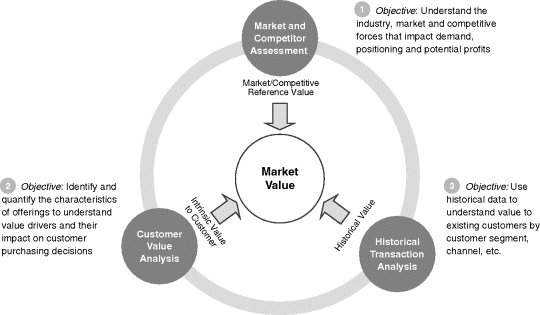Formulating a Value-Based Pricing Strategy
To develop a value-based pricing strategy, a company must first determine the value of its offerings. This can be challenging given the number and variety of factors that must be considered. As discussed earlier in the chapter, customers perceive value through logical, practical, and rational criteria as well as through emotional (e.g., a teenager placing high value on an acne medication), psychological (e.g., a parent valuing a fire alarm system that gives peace of mind at night), and irrational criteria (e.g., a strong aversion to the color blue), which are all are extremely difficult to identify and measure.
Three types of analyses can help calculate or approximate the market value of a product or service (see Figure 3.2). Each analysis can individually provide a helpful assessment, but the analyses should be combined to provide the most accurate estimate of value. The types of analyses are:
- Market and competitor assessment: identifying the industry forces and competitive behaviors that impact the seller's pricing ability
- Customer value analysis: understanding what product characteristics customers will pay for
- Historical transaction analysis: assessing the willingness to pay and price elasticity of existing customers and offerings.
Figure 3.2 Three Approaches for Estimating Market Value

Each of these three approaches on its own is ...
Get Pricing and Profitability Management: A Practical Guide for Business Leaders now with the O’Reilly learning platform.
O’Reilly members experience books, live events, courses curated by job role, and more from O’Reilly and nearly 200 top publishers.

